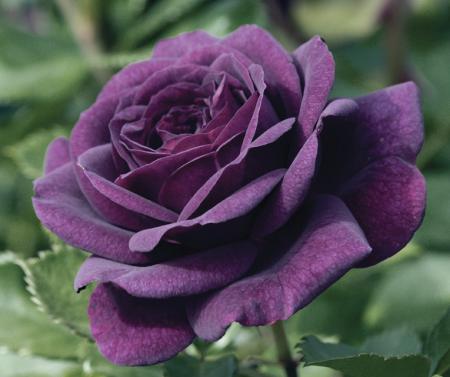 | |
| Ebb Tide™ floribunda rose |
- Plant the bud union 5 cm below the soil line.
- Fertilize with transplanter formula 5-15-5.
- After three or four weeks, change to a brand name rose food. Established roses should be fed every week from early spring to late August.
- On the premise that prevention is easier than a cure, spray once per week with insecticide/fungicide.
- Change from rose food to 0-0-20 (straight potassium) for overwintering vigour.
- Let the last flowers go to seed; do not prune.
- When the soil is frozen, tie up the rose canes, install a rose collar and fill it with soil.
- Remove the collar and then the soil as it thaws.
- Cut back the strongest canes to 10 or 15 cm, cutting to an outward facing bud.
- Start to fertilize when growth begins. Ever blooming roses need to be well nourished.
The rose bed or planting hole should be well-prepared. Dig deep, at least 45 cm. The soil should be two parts sandy clay loam, one part well-composted manure and one part peat moss, plus 4 kg of bonemeal for every 10 square metres or, a cupful for each plant.
Depth of planting
Choice roses are produced by budding selected types to hardy rootstock. The bud union, which may look like a swollen portion at the bottom of the canes, should, in our Canadian climate, be planted one or two inches below the soil. Be aware that American or English publications may specify the bud union be placed ab lvoe above the soil.
Fertilizer
Newly planted, potted roses should be fertilized with diluted transplanter. Follow the label's instructions. Established roses should be fertilized with a name brand rose food. These formulations contain many trace elements essential to the roses' health. Apply in early May, mid-June and again in mid-July.
Watering
Roses should be watered deeply and well once per week. The best method in beds is to use a trickle hose that can be left on running slowly on the ground, thereby avoiding wetting of the foliage and splattering of the soil.
Mulching
Cocoa bean shells make excellent mulch for roses. They dress the bed, conserve moisture and keep down weeds. Other suitable mulches include bark chunks or shredded bark.
Winterizing
Start thinking of over-wintering your roses in mid-July at the time of your last fertilization. The rose canes should be allowed to harden off; they should not be succulent. Reduce the watering schedule in the fall. Allow the last flush of flowers on the plant to go to seed.
When the ground is frozen, (not too early, mid- to late November) "hill-up" the rose canes with soil, which you have kept unfrozen for this specific purpose, to a height of 45 cm. Do not prune at this time, unless the canes are so tall they could whip about in the winter winds, thereby damaging themselves or disturbing the hill of protective soil. Leave as much cane as possible. In beds or in mass plantings, rose collars are a must — they are easy to use and reduce the amount of soil required. Where collars are not used, the hill of soil, once frozen, should be covered with evergreen boughs after Christmas so that the soil remains frozen and does not thaw in mild spells.